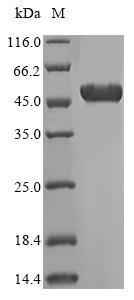Just like other recombinant proteins, the production of this recombinant Human ATP5F1B protein began with appropriate cDNA and PCR methods, and then the ATP5F1B expression plasmids were built. Following sequence determination of the constructs, plasmids were transformed into E.coli for the expression of the recombinant Human ATP5F1B protein. N-terminal 10xHis-SUMO tag & C-terminal Myc tag was used in the process. And we finally get the protein of interest with purity of 85%+.
ATP5F1B (also called ATP5B, ATPMB, ATPSB) is a gene that encodes a subunit of mitochondrial ATP synthase named ATP synthase subunit beta, mitochondrial (also known as ATP synthase F1 subunit beta) in human. Mitochondrial ATP synthase (also known as complex V) consists of two functional domains, F1and Fo. F1 is situated in the mitochondrial matrix, and Fo is located in the inner mitochondrial membrane. This ATP synthase catalyzes the formation of the energy storage molecule adenosine triphosphate (ATP) with adenosine diphosphate (ADP) and inorganic phosphate (Pᵢ).




